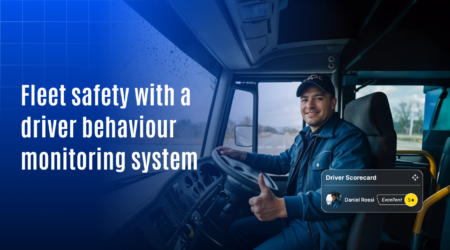How Does Video Telematics Help You Monitor Driver Behaviour in Real Time?

You know where your vehicle is. But what if your driver is texting at 80 km/h, dozing off after a long shift, or taking a route you didn’t authorize? Video telematics can help monitor these situations effectively.
These moments often go unnoticed until they cause real damage, a missed delivery, an expensive repair, or worse, an accident. The truth is, GPS tracking can’t show you what really happens behind the wheel. And by the time an incident reaches your desk, it’s already too late to prevent it.
That’s where a video monitoring system like video telematics steps in giving you live, visual access to driver behaviour in real time.
In this blog, you’ll discover:
- How this technology works
- What real-time driver monitoring looks like
- What you can catch (and prevent) before it becomes a costly mistake
What Is Video Telematics?
Video telematics combines vehicle cameras with real-time data from telematics systems. It gives you a clear view of both the driver’s actions and the vehicle’s performance right as it happens.
It typically includes:
- Road-facing cameras
- Cabin-facing cameras
- Sensors to track speed, braking, and acceleration
- A dashboard that delivers alerts, live footage, and driver reports
You no longer need to rely on assumptions; the data and visuals are all there. Simply put, it’s a video monitoring system designed for vehicles combining visuals and data to help you manage your drivers better.
How Video Telematics Works
Here’s how it all comes together:
- Cameras record the road and cabin in real time
- Sensors track driving behaviours like harsh braking
- AI tools (ADAS, DMS) detect risky actions
- Instant alerts and video clips flag key events
- Managers view everything on a cloud dashboard or app
It’s seamless, fast, and incredibly effective.
Who Should Use Video Telematics?
This isn’t just for large fleets. Anyone responsible for driver safety or vehicle performance can benefit.
- Fleet managers
- Compliance officers
- Safety supervisors
- Business owners
- Driver trainers and coaches
From small fleets to large carriers, real-time visibility keeps your business accountable.
Industries That Benefit the Most
Video telematics has real-world applications in nearly every transport-heavy sector.
In short: Any industry where driver behaviour affects safety, cost, or brand stands to benefit.
Why Real-Time Monitoring with Video Telematics Matters
Many issues on the road happen in a split second. If you’re only reviewing data later, you’re already too late.
In fact, according to a 2023 study by the American Transportation Research Institute (ATRI), over 87% of serious truck accidents involved some form of driver error most commonly speeding, distraction, or fatigue. With a video monitoring system, these behaviours can be identified and corrected before they escalate.
Real-time monitoring allows you to:
- Detect problems as they happen
- Prevent incidents, not just analyze them
- Coach drivers on the spot
- Respond instantly to emergencies
- Reduce downtime and damage
It turns you from a reactive manager into a proactive one.
What Video Telematics Can Monitor in Real Time?
With video telematics, you get much more than just dots on a map.
Here’s what you can catch:
Every event is linked to a time-stamped video clip so you know exactly what happened and when.
Common Mistakes Fleet Operators Make (And How to Fix Them)
Even seasoned managers can miss the mark when it comes to monitoring.
Mistake 1: Relying only on GPS
GPS tells you where your vehicle is but not what’s happening inside.
Fix: Pair GPS tracking with real-time video to gain full visibility into driver behaviour.
Mistake 2: Reacting too late
Waiting for an accident or complaint wastes time and money.
Fix: Real-time alerts let you act before it’s too late.
Mistake 3: No video evidence during disputes
Without visual proof, you’re at a legal and financial disadvantage.
Fix: Video recordings protect both your business and your drivers.
Mistake 4: Giving generic coaching
Not all drivers make the same mistakes but many get the same training.
Fix: Use real footage to offer personalized, impactful feedback.
Key Features of Video Telematics for Real-Time Driver Monitoring
Powerful tools that deliver instant visibility:
- Live Streaming: View trips in real time
- Instant Alerts: Get notified of unsafe actions
- ADAS: Detect lane drift, tailgating, collisions
- DMS: Spot distraction, drowsiness, tampering
- Trip History: Replay past journeys with video
- Driver Scorecards: Track behaviour-based performance
Business Benefits That Go Beyond Safety
Monitoring in real time does more than reduce risk; it delivers real business value.
Companies that implement real-time driver monitoring report up to 35% fewer accidents and 25% lower insurance claims, according to Fleet Safety Index reports.
Here’s how:
- Prevent accidents and protect assets
- Lower insurance premiums
- Cut down on vehicle wear and tear
- Improve customer satisfaction
- Resolve claims faster with video evidence
- Create a culture of safety and accountability
How Video Telematics Helps Drivers Improve Performance
Real-time visibility doesn’t just help managers it helps drivers too.
With the right approach, you can:
- Show drivers exactly what went wrong
- Coach respectfully and effectively
- Recognize good driving with rewards
- Reduce stress by protecting them from false claims
- Improve morale by showing that safety matters
When drivers feel supported, not watched they drive better.
Summary: See the Full Picture, Act in the Moment
A video monitoring system gives your clients real-time visibility into what matters most with people and vehicles both. Your clients get more than data. They get full context with a powerful video monitoring system built for real-time driver visibility.
With real-time driver behaviour monitoring, your clients can:
- Prevent accidents
- Coach smarter
- Operate safer fleets
- Improve your bottom line





